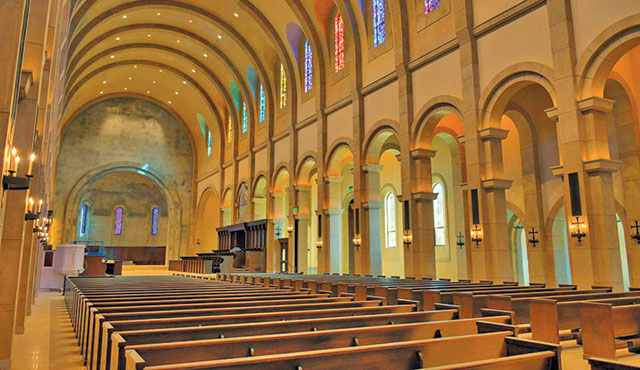Ever ancient, ever new. This was how Pope St. Paul VI described the Church in the modern world. It can also be applied to the spiritual presence of the Norbertines in Orange County. Construction neared an end this year on the order’s new St. Michael’s Abbey, off Silverado Canyon Road in Silverado. Located just under seven miles north of the original home of the Norbertines in Trabuco Canyon, the new abbey sits on 327 acres.
Due to moving delays, this year’s Christmas liturgies and festivities will be observed at the current abbey, Casey Cook, director of external communications and events, noted. The logistical requirements of moving such an entity as an entire abbey is another factor in the gestating process. Anyone who has moved in their own lives knows how demanding the process is.
“It’s daunting but doable,” Father Miguel Batres, coordinator of the move to the new site, commented. “We have wonderful teams of Norbertine confreres and friends of the abbey who are invaluable in helping everything come together.”
In addition to the abbey, which houses about 50 priests and 35 seminarians, the property is also home to St. Michael’s Preparatory School, the all-male boarding high school of over 60 students, which includes a dormitory, classrooms, offices, athletic field, outdoor swimming pool and basketball court.
Also relocating with the Norbertines are the Dominican Sisters of the Holy Rosary, a welcomed presence on abbey grounds since 1977, assisting the priests in a number of capacities. A convent and chapel for the sisters was also part of the sprawling new construction project.
Finally, in addition to a seminary with classrooms and lodging, a commercial kitchen and dining hall, the new abbey in Silverado Canyon contains a church large enough for almost 350 people.
The architecture of the church and abbey overall reflects the Norbertine passion and commitment to truth, beauty, and goodness. The inspiring serenity of the sacred buildings and grounds echoes the quiet dignity of the Norbertine persona, their white cassocks a spiritual staple in Orange County since their arrival in 1961.
Fr. Jerome Molokie identified Moroccan-born French architect Jean Louis Pagès to become chief architect of the new abbey design. Born in 1933, the prolific architect’s main career focus has been in monastic architecture. It was a passion sparked after Pagès visited a Benedictine uncle at the Abbey of Hautecombe in present-day southeastern France, the traditional burial site for members of the House of Savoy, owners of the Shroud of Turin for over 500 years. When Pagès designed his family home in 1970, he drew inspiration from Richard Neutra, the Southern California architect behind the Tower of Hope and Arboretum at Christ Cathedral.
“Jean-Louis Pagès is truly a Renaissance man: architect, painter, writer, and historian,” Father Jerome said. “He is also kind and approachable, someone who immediately makes you feel at ease in his presence.”
The Norbertines knew what they wanted: a classical structure that not only reflected their solemnity of worship, but was distinct from the kind of modern religious structures that populate the Southland today. They saw in the work of Jean Louis Pagès the ideal sacred space.
Abbot Eugene Hayes clarified, “We do not reject anything in the new that is good, but we hold on to all that is good in the old.”
The project took on great personal meaning for Jean-Louis Pagès when the Norbertines contacted him about designing the new St. Michael’s Abbey. When told the abbey’s namesake was St. Michael the Archangel, emotion washed over Pagès. Michael was the name of Pagès’s only son, who died unexpectedly sixteen years earlier.
Pagès designed the church in such a way that on the feast of St. Michael, September 29, the sun shines through in a perfect straight line across the whole of the church. Such a feat is more than an attractive visual, but speaks to the light of faith, the lumen fidei, that drives both Jean-Louis Pagès and the Norbertines in their mission to bring Christ, the light of the world (Jn. 8:12), to the modern world.
The experience of building the new St. Michael’s Abbey church not only gave Pagès time to rekindle memories of his departed son, but was a manifestation of the beauty that arises out of suffering.
Though the Norbertines are not monks, the monastic approach infuses their approach to the world. The abbey grounds nestled in remote Silverado Canyon offers pilgrims an opportunity to reflect on the meaning of life and living the faith. Here one feels as if they are stepping onto the quiet of a French monastery or a Jerusalem abbey. The constant whir of modern activity ceases, and the words of the Psalmist can be heard: “Be still and know that I am God” (Ps. 46:10).
Cook expects the dedication of the abbey church to take place in May 2021.


